TOTIPOTENT — NOT WHAT IT SOUNDS LIKE
/2 Comments/in Flowers, Fruit, Uncategorized/by Lee ReichCells Beget Plants, or Animals
As I strode out to the garden today, the word “totipotency” was forefront in my mind. No, I wasn’t thinking of myself as “all powerful,” which is what totipotent (Latin totus=whole, potent=powerful) might seem to mean.
Totipotency is the ability of any cell in an organism — you, me, my dog Sammy, my rose bush — to potentially give rise to any other kind of cell of that organism, or to a whole new organism, a clone of the original. Under the right conditions, you could put one of your skin cells in the right environment, and have those cells grow into new skin, toes, eyes — even a whole new you. Fortunately, nobody has yet figured out how to do that with a human.
(What I wrote is not exactly true. Not every cell within an organism is totipotent. In organisms that reproduce sexually, egg and sperm cells — the germ cells — have only half their complement of genes, so these particular cells can’t be cloned to reproduce non-germ cells or whole organisms.)
Back to the garden and totipotence . . . Using random plant parts to make whole new plants is nothing new to most gardeners. With stem cuttings, for example, you put a stem into a suitable environment, and it’s induced to grow roots at its base and new shoots, followed by flowers and, perhaps, fruits, above ground. With leaf cuttings, all these new parts spring from a mere leaf.
Stems and leaves are more than just a few cells. More specialized, but still feasible, is cloning with just a few cells: so-called micropropagation or tissue culture. A few cells are removed, usually from a growing point, and then, under sterile conditions, put into a petri dish containing a medium to supply nutrients and a balance of plant growth hormones. The cells multiply without differentiation into anything special until they are transferred to another medium, this one with an altered balance of hormones, that induces cells to differentiate into leaves and roots. After a period of growth, the plantlets graduate to real soil.
Micropropagation is a way to create many new, pest-free clones quickly and from a minimum of amount of mother plant.
Apolitical Graft
My foray into “totipotencing” plants today required pretty much nothing more than pruning shears. I was cutting scion wood, which are stems for grafting onto growing plants. In this case, the growing plants — the rootstocks — provide roots to the clone; the completed plant, from the graft upwards, is the clone, in this case various varieties of pears.

Watersprouts on old apple tree
In the past, I’ve done a “Henry IVth” on pear trees whose fruits were not up to snuff, then grafted a more desirable scion on to the decapitated trees. Today’s scions are for grafting onto one-year-old pear seedlings, to make new pear trees. (Not that I need that many pear trees. The grafting will be done by participants at a couple of grafting workshops I’ll be holding this spring. Stay tuned to my website for when, where, and other details.)
Grafts are most successful with young scions — one-year-old stems, those that grew last season. They come in various sizes, depending on their vigor; pencil-thick is about right. I cut them into foot-long lengths. Watersprouts, those vigorous, vertical branches often appearing in the upper parts of a tree, are good for scionwood, and most, anyway, should be removed.
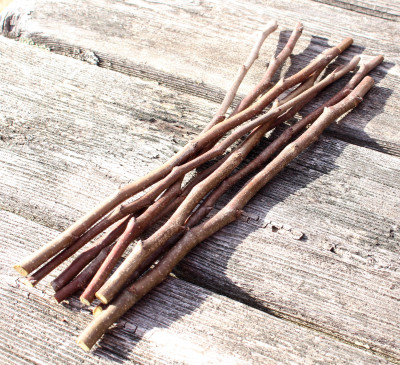
Pear scions
The odds for success are also increased if grafting takes place with dormant scions grafted on rootstocks that are either dormant or awakening. That’s why I collected scions today; they’re still dormant, but not for long, outdoors.
I’ll keep those scions dormant with cold, in the refrigerator or my mudroom (north side of the house, tile floor over concrete).
Drying out would spell death to the scions, as it would to any living plant or plant part. They need to be kept hydrated, but not in so moist an environment as to cause rotting. So I store them in a plastic bag, around which I wrap a moist towel, and then put the towel-wrapped bag into another plastic bag, well-sealed.
I Was Wrong About Arnold
I was wrong. Back in December, I wrote, “My Arnold’s Promise witchhazel usually flowers in March. This year’s October flowering means no flowers this coming spring.” Well, it’s March 1st as I write this, and Arnold’s Promise is showered with strappy, yellow blossoms.
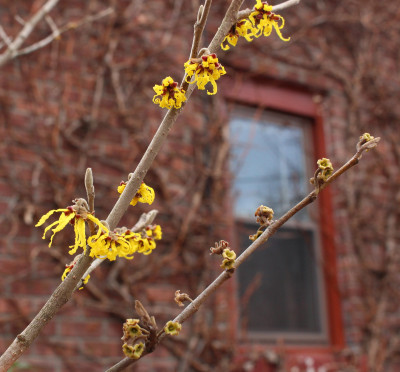
Witchhazel’s winter flowers and remains of fall flowers
Evidently, not all flower buds slated to open this month opened prematurely, last October. Some did as they are supposed to do: waited. Why? Good question. Looking at the shrub, a location effect does not seem to come into play. Late winter blossoms seem randomly distributed rather than concentrated on older, younger, lower, higher, southern, or northern stems.
With no explanation coming to mind (yet!), I’ll just relax and enjoy the unexpected show.
GREENING UP
/2 Comments/in Gardening, Vegetables/by Lee ReichChickweed, Not for Me
Warmish days come and go, but I’m not twiddling my thumbs waiting for spring to come early, late, or vacillate. True, I have a greenhouse. Even there, though, weather can be quite cool, down into the 30s at night and on overcast days.
A few plants that are good for fresh, salad greens aren’t just surviving under these conditions; they’re thriving. And with very little effort on my part because rather than cultivating them, they grow so profusely that I have to weed out excess before they take over the greenhouse.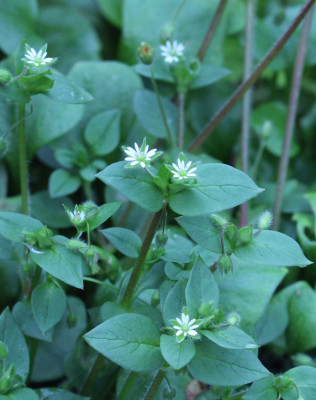
Speaking of “weed,” one of them really is a weed, at the very least in name: chickweed (Stellaria media). This weed loves cool weather; it’s been sprouting in the greenhouse all winter. It’s also no stranger to the garden outside the greenhouse, where winter temperatures snuff it out so that each year it must return from seeds it sows. In the greenhouse, it might become — perhaps is now — perennial.
Chickweed is tasty and nutritious. I don’t doubt the second adjective but disagree with the first. I wish I liked the flavor. Because I don’t, I’ll spend some time today in the greenhouse weeding it out.
Claytonia All Over the Place
The greenhouse is also pleasantly indundated with claytonia (Claytonia perfoliata), another wilding cultivated for salads, perhaps soups(?), in cool weather. This green is native to California, where it drops its seeds in spring; cool, moist weather of fall induces sprouting whence it blankets Western ground in green all winter long.
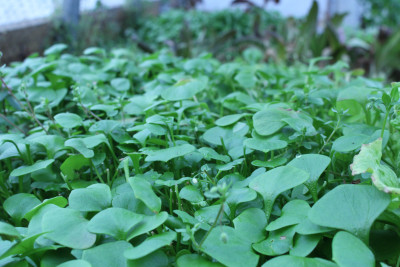 Conditions in my greenhouse are very similar to those of norther California. (Claytonia is sometimes called miner’s lettuce because Gold Rush miners ate it to prevent scurvy.) Years ago I sowed some claytonia seeds in greenhouse beds. No longer is that necessary. Those first plants came up in the straight lines of my furrow. Nowadays, they blanket the ground as a lush edible groundcover, mostly near the sidewalls where rain washed down from the roof and into the ends of the beds when I rolled up the sidewalls in summer for ventilation.
Conditions in my greenhouse are very similar to those of norther California. (Claytonia is sometimes called miner’s lettuce because Gold Rush miners ate it to prevent scurvy.) Years ago I sowed some claytonia seeds in greenhouse beds. No longer is that necessary. Those first plants came up in the straight lines of my furrow. Nowadays, they blanket the ground as a lush edible groundcover, mostly near the sidewalls where rain washed down from the roof and into the ends of the beds when I rolled up the sidewalls in summer for ventilation.
The plants make more than just an edible groundcover; they make an edible, ornamental groundcover. The tender stalks rising from ground level are capped by heart-shaped leaves, in the center of which eventually sits a cluster of small, white flowers. I’d use it as a winter groundcover if it could survive our winters; temperatures below about 10°F kill it.
The flavor is nothing to write home about. It’s mild, to say the least. Perhaps its greatest contributions to cold weather salads are color and texture.
Make Mine Mâche, My Favorite
Some people might say the same thing about mâche (Valerianella locusta), in my experience the most cold-hardy of all salad greens. It’s ready for harvest no matter how cold the weather in the greenhouse, or out, and will actually grow a little with the slightest degree of warmth whether natural or from the protection of a south wall or a cold frame.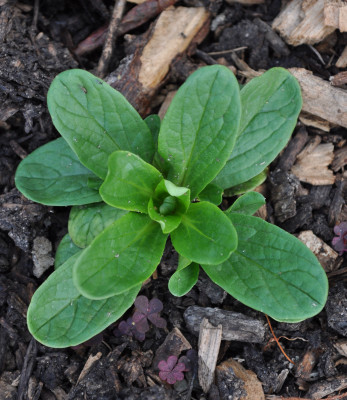
To me, mâche is the most delectable of salad greens. It also self-seeds both in the greenhouse and outdoors. What else can you ask for in a plant: tasty, available all winter, no need to plant.
Like claytonia, mâche is a cool weather annual. Sow it in summer and nothing happens. Sow it under cool, moist conditions and it sprouts readily. This is another salad green that I planted years ago, but not since. Cultivation of mâche entails, mostly, pulling up wayward or excess plants before they expire and drop seed in late spring, in so doing preventing it from becoming weedy.
Mâche is a European import, a centuries-old favorite only of the peasantry until the gardener to Louis XIV gave it street cred’. In English-speaking countries, it’s sometimes called “corn salad” because it’s a weed of grain fields, “corn” in the Queen’s English being any kind of grain, not necessarily and not usually corn, which they call maize. If I had a grain field, I’d welcome some corn salad for tender, tasty salads almost all winter long.
DOING SOMETHING ABOUT (MICRO)CLIMATE CHANGE
/10 Comments/in Fruit, Gardening/by Lee ReichMicroclimates, Here, There, and Everywhere
Mark Twain wrote that “Everyone complains about the weather but nobody does anything about it.” I’m going to step up to the plate and do something about it — not the climate but the microclimate. “Microclimate” is the very local weather. And I do mean “very local,” as, for example, right around a particular plant.
Different microclimates exist all around my property — and yours. Near the south wall of my brick house for example, winter low temperatures don’t plummet nearly as low as they do, say, 30 feet away from the wall. The bricks are very good at absorbing the sun’s heat, then let it slowly ooze out after nightfall. Near that wall is where I’m planning to plant out a Kadota fig tree now dormant in my basement. (Come late fall, after harvest, I’ll dig up the tree with a good root ball and return it to winter quarters in the basement.)
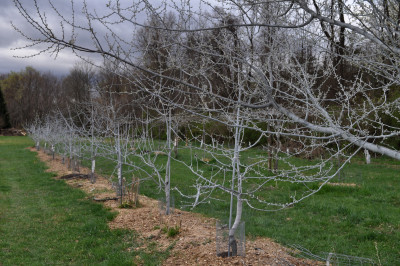
‘Surround’, a white clay, sprayed on apples
On the other side of my house, where sunlight can’t fall in winter, days and nights are colder than the general temperatures, and remain colder from spring through fall. Near that north wall, then, would be a good place to plant an apricot or peach tree to delay unfolding of their blossoms, which otherwise open so early that they often succumb to subsequent spring frosts. Dead blossoms mean no crop for that season.
Apricots and peaches, like most fruits need sunlight to fuel the most flavorful fruits. Although areas near the north wall are shaded — and hence cooler — in winter, from spring through early fall the sun wraps enough around the sky from the northeast to northwest corners to cast its light there.
Other influences on microclimate include fences, land sloping in various directions, paved areas, plant or built windbreaks, and changes in elevation.
(Micro)Climate Modification
Much of what I have planted, including many fruit plants, are nowhere near fences or paving, and my land is mostly flat. It is lowland, in a valley, and cold air, which is heavier than warm air, collects in this low spots, to threaten the blossoms on my fruit plants with late, killing frosts.
Mark Twain notwithstanding, I’m going to try doing something about the weather — the microclimate, in this case — on plants nowhere near walls, fences, or paving.
Enter ‘Surround’, the trademark name for a special formulation of kaolin clay. This product was developed about 30 years ago mostly as a nontoxic way to thwart insect pests. It’s especially useful for controlling plum curculio, a pest of plums, peaches, apples, and some other fruits; curculio isn’t easily controlled by other organic methods.

‘Surround’ spray on blueberries
Kaolin is white, so when a sufficiently thick coating of ‘Surround’ is built up on branches, they appear white. Old Sol’s rays just bounce off white surfaces, the surfaces, in this case being the buds of fruit plants. So the buds stay cooler, delaying bloom, hopefully until after threat of frost has past.
I’ve already given the plant a couple of coats of ‘Surround’, and they already have a sun-drenched, gray-cast, Mediterranean look to them. A couple more coats will make the visual effect more dramatic, both to me and Ol’ Sol, and will get a jump on curculio control.
Awake too Soon
Downstairs, in the basement, things are not as quiescent as hoped. That’s where the figs, pomegranates, and mulberries are spending winter, the cool (45°F) temperature holding back growth. Or so I thought.
One plant, Pakistan mulberry, has decided to awaken. This mulberry is a species of white mulberry (Morus alba) that differs markedly from the white mulberries you see here. Pakistan is only about as cold-hardy as fig (which is why they share winter quarters in my basement) and bears a very delicious, dark purple fruit up to three inches long!
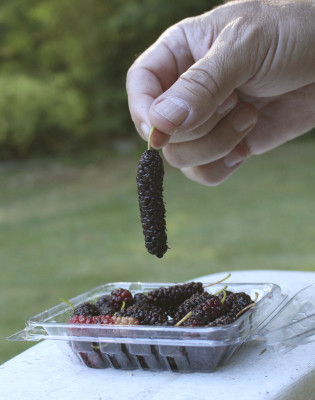
‘Pakistan’ mulberry
Pakistan evidently has a low chill requirement, that is, it does not take much cold for it to feel like winter has ended so it can begin growing. Different plants have different requirements for the number of hours of chilling, which is temperatures between about 30 and 45°F., they need to be exposed to before they can begin growth for the season.
I may have to move the budding plant into the greenhouse where it really is spring, with temperatures at least into the 70s on this sunny day.

